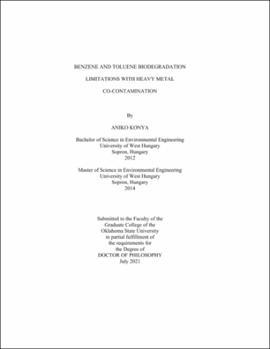| dc.description.abstract | Bioremediation depends on microorganisms. Low bioavailability of pollutants, high heavy metals' concentration, and insufficient nutrients for microorganisms lead to biodegradation limitations of co-contaminants. Bioremediation is underutilized in co-contaminated sites because of the suspicion and disagreement over its efficiency. Understanding the effect of high concentrations of lead, cadmium, and zinc on the biodegradation of benzene and toluene is needed to improve and enhance the utilization of existing bioremediation practices for co-contaminants. This study identifies native soil aerobic degraders of individual benzene (876.4 mg/kg) and toluene (869.8 mg/kg) in the presence of various concentrations (5.1 mg/kg; 51 mg/kg; 510 mg/kg; and 5,100 mg/kg) of Cd and Pb. The study analyzes the microbial community structure and diversity in aerobic microcosms using several molecular biology techniques. The study also demonstrates and assesses bioremediation potential for benzene (876.4 mg/kg) and toluene (869.8 mg/kg) in Cd (between 7.9 and 341.8 mg/kg), Pb (between 187.5 and 8,772 mg/kg), and Zn (between 860 and 79,341 mg/kg) long-term polluted soils collected from Tar Creek Superfund site in Oklahoma. The bioremediation potential is studied on a laboratory scale in aerobic microcosms utilizing molecular biology and analytical methods. Individual benzene or toluene without heavy metal co-contaminants displayed similar bacterial community distribution. The bacterial community distribution was significantly different statistically when Cd was present, depending on the Cd concentration. Lysobacter sp., Rhodococcus group, Caulobacter daechungensi, Pseudomonas sp., Pseudomonas putida, Mesorhizobium sp., Adhaeribacter sp., Flavobacterium limicola, and Flavobacterium granulensis presented high (<104) 16S rRNA genes/g, indicating a viable bacterial population for an efficient bioremediation process in co-contaminated sites. Rhodospeudomonas sp., Zoogloea sp., Cupriavidus sp., Nitrosospira sp., Dechloromonas sp., Nitrosovibrio sp., and Nitrospira sp. were presented in high abundance in the experimental soils selected for the bioremediation study. They demonstrated the ability to degrade a mixture of benzene (876.4 mg/kg) and toluene (869.8 mg/kg) without limitation in the presence of long-term heavy metal-contaminated soils. Benzene degradation was linear for natural attenuation, while toluene degradation was linear for biostimulation and natural attenuation. The degradation rates between biostimulation and natural attenuation were significantly different (P<0.05) in soils polluted with the lowest and highest heavy metal concentrations. | |
